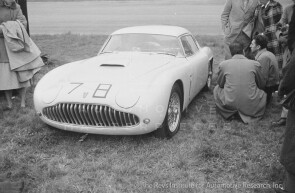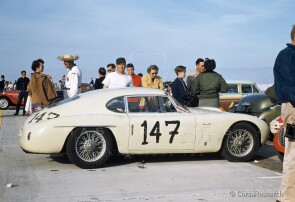
1952 Siata 208CS
ON/OFF
Why am I an Automotive Masterpiece?
G. Team cars
Squadra Siata (IT)
L. Limited edition cars
no. 6 manufactured, 3rd built. Only 6 cars with Stabilimenti Farina body
In the postwar period, Fiat was working on an eight-cylinder engine internally known as Tipo 106. The engine was originally designed by Dante Giacosa for a luxury sedan, but that project was stopped. Rudolf Hruska, at the time working at the S.I.A.T.A., was given the task to design a car around the V8 engine. The development took place in absolute secrecy. As not to stress the experimental department of Fiat, production of the chassis was also taken up by S.I.A.T.A. Styled by chief designer Fabio Luigi Rapi, the Fiat 8V or “Otto Vù” was presented to the Italian press in February 1952 and first exhibited the following March at the Geneva Motor Show. The car shapes saw several changes in time: the prototype used an art deco grill extending into the hood which initially characterized the examples of the first series. A second series was made featuring four headlights with some of the later cars having a full-width windscreen. A high-performance coupé, destined to compete in the GT class: the 2-liter 8V model was a departure from the usual Fiat production. It was really welcomed by Italian private drivers, it inspired the tuners and it was, in a word, the car to beat in the 2-liter class, also thanks to the special versions built by Zagato or S.I.A.T.A. The Fiat V8 had a 70° V configuration of 1996 cc of displacement, at 5600 rpm the engine produced 105 hp (78 kW) in standard form with double two-barrel Weber 36 DCS carburetors, giving a top speed of 190 km/h (118 mph). Some engines were fitted with huge four-throat Weber 36 IF4/C carburetors offering 120 bhp, but the intake manifold was very rare. The Fiat 8V is the only eight-cylinder built by Fiat. The engine was connected to a four-speed gearbox. The car had independent suspension all round reworking the Fiat 1100 ones and drum brakes on four wheels. As the body was welded to the chassis it was a semi-unitary construction. Only 114 of these high-performance coupés had been produced, 63 with a “Fiat Carrozzerie Speciali” body, 34 first series and 29 second series. It was made available anyway in different body styles, offered by the factory and by various coachbuilders like Zagato, Pinin Farina, Ghia and Vignale. The production ceased in 1954.
S.I.A.T.A. played a pivotal role in the development stages of the Fiat “106” project, designing and constructing the prototype. The company also produced the initial six pre-production cars and likely handled the final setup of all the V8-powered cars entered for the 1952 races. During the development of the 8V, Giorgio Ambrosini contemplated the idea of creating a sports car based on the same mechanics. It is highly probable that early in the 8V program, arrangements were made with Lingotto to build S.I.A.T.A.'s own car. The S.I.A.T.A. 208CS (Competizione Sport) was crafted around an in-house designed chassis. Although using similar oval chassis tubes (9.5 cm by 6 cm wide), the design differed from Fiat's. On the 208CS, the main longitudinal spars were bent to the inside in the middle, resembling a Coke bottle. This allowed the two bucket seats to be placed between these and the outer tubes, lowering the overall height of the car. In contrast, on the six pre-production Fiat 8Vs, the oval tubes were straight. When Fiat transitioned to series production, it switched to a chassis built internally at Lingotto, maintaining the same design but with round tubes. On S.I.A.T.A. 208CS, the 2-liter V8 engine was coupled to a 5-speed gearbox, deviating from the standard 4-speed in Fiat cars. S.I.A.T.A. was involved in the setup of the OttoVu and was the first to race an 8V-powered car, entering a 'test' car for the XII Giro di Sicilia in 1952, driven by Franco Rol and Gino Munaron. The prototype had a chassis and engine concealed under a modified Daina Gran Sport body, possibly due to the unavailability of the Stabilimenti Farina body or as a camouflage for an endurance test for both Fiat and S.I.A.T.A. engineers. This was captured by Corrado Millanta. Aside from his efforts, there was little press coverage for the model. It's noteworthy that the race took place ten days before the official launch of Fiat's OttoVu at the XXII Salon Automobile de Geneve, while S.I.A.T.A. revealed its definitive 208CS at the 1952 Salone dell’Automobile in Torino. Stabilimenti Farina crafted the aluminum body, possibly designed by Giovanni Michelotti. There's no concrete proof, as he worked as an independent consultant at that time, like Giovanni Savonuzzi, who was introduced at S.I.A.T.A. by Hruska. The S.I.A.T.A. 208CS was one of the lowest sports coupés ever built, featuring retractable headlamps – a novelty for its day – and an aggressive grille with vertical “teeth.” The interior was minimalist, with a dashboard dominated by a large central tachometer surrounded by four smaller dials. The four-spoked wood-rimmed steering wheel was removable, and the bucket seats were the same as those in the 8V. Different cars were exhibited in Torino at various times, as three examples also had to be prepared for the most important race of the year. At the 1952 Mille Miglia, S.I.A.T.A. arrived with three aggressive yet smart-looking 208CS cars, built by Stabilimenti Farina, with chassis numbers CS*052*, CS*055*, and (believed to be) CS*053*. It's highly likely that S.I.A.T.A. had bigger plans for the race, but ultimately, only these three cars participated. Furthermore, while Fiat 8Vs were entered in the new GT class, with equally powered competitors, the S.I.A.T.A. 208CS was forced to race in the Sport class, where the competition was tougher. This likely happened because the 208CS didn't meet the required minimum production or because its dimensions did not conform to the regulations. Some even suggest that Fiat didn't want it to compete with the OttoVu in the same class. S.I.A.T.A. produced three more 208CS coupés with Stabilimenti Farina bodies: chassis no. CS*056*, CS*058*, and CS*059*. They are easily distinguishable from the earlier cars by the hot air exit port in the front fenders. During this period, the coachbuilder, who had S.I.A.T.A. as its most important client, faced financial difficulties and went into receivership before closing its doors at the end of 1952. Giorgio Ambrosini enlisted the craftsmanship of the nearby Carrozzeria Balbo to continue the limited production of the car. Balbo used the same chassis, but now the main longitudinal tubes were straight (such as in the Fiat 8V), giving the car a higher and less sleek appearance. A total of only 15 cars were produced, including both Stabilimenti Farina and Balbo examples. S.I.A.T.A. didn't focus solely on competition cars and built a few “granturismo” models with bodies by Bertone and Vignale. The arrival of the 208S spider in 1953 marked the beginning of a new era.
The S.I.A.T.A. 208CS with chassis no. CS*055* is one of the six examples bodied by Stabilimenti Farina. Originally painted in ivory white, it was likely one of the cars presented (displayed in turns) at the 1952 Salone dell’Automobile in Torino. Most importantly, it is one of the three 208CS entered in the 1952 Mille Miglia, and the only one to reach the end of the race, driven by Franco Rol and Gino Munaron. They finished 11th overall on Viale Venezia. CS*055* was privately owned; official documents showed that Rol acquired and licensed the car just before the race, while chassis no. CS*052* and CS*053* were “almost-works” since they were entered and driven by S.I.A.T.A. dealerships. Munaron recalled that after the race, Franco Rol traded his car for a loan for a 208S spider that, however, was never delivered. The coupe returned to the S.I.A.T.A. headquarters on Via Leonardo da Vinci. Renato Ambrosini received a request from the US for a new car. Chassis no. CS*055* had all racing fittings removed, was retrimmed, and received a new paint job. A new engine was fitted too; the original engine no. CS*055* was replaced by CS*013* (punched SC*013*) that came out of CS*051*. According to authoritative Tony Adriaensen, the car received a new chassis number: CS*060*, with the last two digits stamped and applied over the original CS*055* numbering. However, upon direct examination, there is no trace of this change having occurred. The American client was the enthusiastic racer Otto Linton, owner of Speedcraft Enterprises, who ordered the car through Tony Pompeo but went to Italy himself to take delivery of it in August 1952. Linton drove it all over Europe to break it in before racing at Watkins Glen in September. It was the first 208CS to reach American soil, and Linton raced it intensively, frequently achieving podium finishes and securing top positions in class. In the business of trading exotica, Linton eventually sold CS*055* to the racing driver Bob Murrell, who took the car on in a series of club races in 1954. The following year, the car, now disappeared from the racing scene, was advertised for sale, and later sold to Ernie McAfee, who had it restored and repainted in red. Later, the new owner Frederick Miller installed a Buick V8 engine to make the car run; it is not known whether this was due to difficulties in maintaining the original engine or otherwise. Around the mid-1970s, CS*055* was in Wilmington, Delaware, where it was acquired by Knute Kolman from San Francisco, who undertook a complete restoration, placing the SC*013* engine back in its place. Kolman mentioned that the valvetrain had suffered, so the center main feed from the crankcase had to be modified to bring more oil to the top end. The measured center main feed was approximately 1.5mm which carried the oil at a slow rate. The measuring cap was then removed to use the entire hole opening (perhaps 5 to 6 mm). It appears that many other 106-type engines were modified in this way over time. By the end of the 1990s and the beginning of the 2000s, Kolman parted with the car, selling it to an important private collection. The car is featured in many publications, such as Sandro Binelli’s 'Mille Miglia’s Chassis' book, Volume III."





